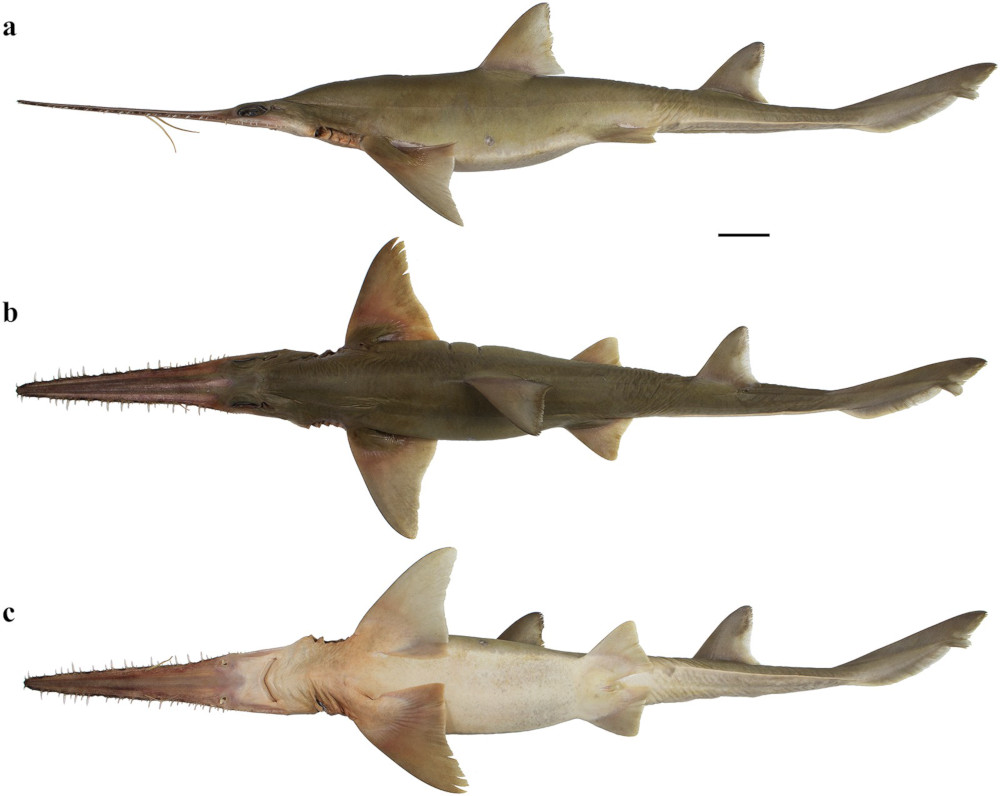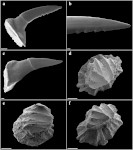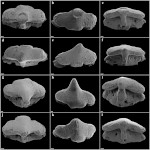Pliotrema annae
Weigmann, Gon, Leeney & Temple, 2020
Anna’s sixgill sawshark
Classification: Elasmobranchii Pristiophoriformes Pristiophoridae
Reference of the original description
Revision of the sixgill sawsharks, genus Pliotrema (Chondrichthyes, Pristiophoriformes), with descriptions of two new species and a redescription of P. warreni Regan. PLoS ONE, 15(3), Article e0228791
Revision of the sixgill sawsharks, genus Pliotrema (Chondrichthyes, Pristiophoriformes), with descriptions of two new species and a redescription of P. warreni Regan. PLoS ONE, 15(3), Article e0228791
Description :
Citation: Pliotrema annae Weigmann, Gon, Leeney & Temple, 2020: In: Database of modern sharks, rays and chimaeras, www.shark-references.com, World Wide Web electronic publication, Version 04/2024
Please send your images of "Pliotrema annae" to info@shark-references.com

Pliotrema annae Weigmann, Gon, Leeney & Temple, 2020, holotype, ZMH 26361, presumably adult female, 981 mm TL, scale bar: 5 cm. © Dr. Simon Weigmann, Elasmobranch Research Laboratory, Hamburg, Germany

Pliotrema annae Weigmann, Gon, Leeney & Temple, 2020, holotype, ZMH 26361, presumably adult female, 981 mm TL, scale bar: 5 cm. © Dr. Simon Weigmann, Elasmobranch Research Laboratory, Hamburg, Germany
Common names
 Annas Sechskiemer-Sägehai,
Annas Sechskiemer-Sägehai,  Anna’s sixgill sawshark
Anna’s sixgill sawshark
 Annas Sechskiemer-Sägehai,
Annas Sechskiemer-Sägehai,  Anna’s sixgill sawshark
Anna’s sixgill sawshark
Short Description
Diagnosis after WEIGMANN et al., 2020 [28258]: A medium-sized six-gilled sawshark with the following characters: barbel origin to anterior nostrils 1.9–2.0 times anterior nostrils to symphysis upper jaw; prenarial length 1.6–1.7 times prebarbel length; preoral length 1.5–1.7 times interdorsal space; pectoral-fin anterior margin 1.4–1.5 times dorsal–caudal space; mouth width 2.7–3.2 times spiracle length. First dorsal fin originates about opposite pectoral-fin free rear tips. Lateral trunk dermal denticles tricuspidate, rather flat and imbricated. Color uniform medium to dark brown dorsally without longitudinal stripes; white ventrally but with few indistinct dark blotches on belly; fins with pronounced white posterior fin margins, particularly caudal and pectoral fins; dorsal rostrum surface with two distinct longitudinal dark stripes, lateral rostral teeth dark-edged. Monospondylous centra 53–54; precaudal diplospondylous centra 46–49; total vertebral centra 154. Pliotrema annae is distinguished from its two congeners by a combination of characteristics, including a generally shorter snout, with head length 34.2–34.5% TL, preorbital length 21.7–22.0% TL, preoral length 24.6–25.1% TL, prebarbel length 12.6–12.7% TL, and barbel origin to symphysis upper jaw 12.1–12.3% TL. Pliotrema annae further differs from its two congeners in lower total large lateral rostral tooth and ventral rostral spine counts, and a rostrum that is slightly constricted between barbel origin and nostrils. Like in P. kajae, the barbels are situated about half way from rostral tip to mouth, with prebarbel length about equidistant from barbel origin to symphysis of upper jaw. In contrast, the barbels are situated about two thirds way from rostral tip to mouth, with prebarbel length about twice distance from barbel origin to symphysis of upper jaw in P. warreni.
Diagnosis after WEIGMANN et al., 2020 [28258]: A medium-sized six-gilled sawshark with the following characters: barbel origin to anterior nostrils 1.9–2.0 times anterior nostrils to symphysis upper jaw; prenarial length 1.6–1.7 times prebarbel length; preoral length 1.5–1.7 times interdorsal space; pectoral-fin anterior margin 1.4–1.5 times dorsal–caudal space; mouth width 2.7–3.2 times spiracle length. First dorsal fin originates about opposite pectoral-fin free rear tips. Lateral trunk dermal denticles tricuspidate, rather flat and imbricated. Color uniform medium to dark brown dorsally without longitudinal stripes; white ventrally but with few indistinct dark blotches on belly; fins with pronounced white posterior fin margins, particularly caudal and pectoral fins; dorsal rostrum surface with two distinct longitudinal dark stripes, lateral rostral teeth dark-edged. Monospondylous centra 53–54; precaudal diplospondylous centra 46–49; total vertebral centra 154. Pliotrema annae is distinguished from its two congeners by a combination of characteristics, including a generally shorter snout, with head length 34.2–34.5% TL, preorbital length 21.7–22.0% TL, preoral length 24.6–25.1% TL, prebarbel length 12.6–12.7% TL, and barbel origin to symphysis upper jaw 12.1–12.3% TL. Pliotrema annae further differs from its two congeners in lower total large lateral rostral tooth and ventral rostral spine counts, and a rostrum that is slightly constricted between barbel origin and nostrils. Like in P. kajae, the barbels are situated about half way from rostral tip to mouth, with prebarbel length about equidistant from barbel origin to symphysis of upper jaw. In contrast, the barbels are situated about two thirds way from rostral tip to mouth, with prebarbel length about twice distance from barbel origin to symphysis of upper jaw in P. warreni.
Dentition
Teeth unicuspidate, in well-defined series, bases oval and flattened with short but pronounced, narrow median cusp near middle of jaw, no lateral cusps; cusps diminishing in height towards jaw angles, indistinct near jaw corners; about 4–5 series of functional teeth. Median cusp with labial face slightly convex and with both mesial and distal cutting edges weakly bent mesially and distally in occlusal view, respectively. The mesial and distal crown base parts somewhat curve apically. A pronounced and broad, irregularly shaped apron overlaps the junction of crown and root, building a notch at the junction with both mesial and distal crown base parts. Basal ornamentation, striae, reticulations and folds absent in both upper and lower jaw teeth. The lingual face of the cusp is strongly convex, a well-developed uvula is present at the central crown base. The mesial/distal latero-lingual crown faces curve strongly towards the apex of the crown, forming a sharp notch with the uvula. The root is anaulacorhizid and slightly arched without lobation. The outer surface of the root shows large basal foramina, which are mostly oval-shaped. The inner face of the root shows well-developed foramina along the crown-root junction at each side of the uvula. The basal face of the root is flat, partly showing some outer foramina. [28258]
Teeth unicuspidate, in well-defined series, bases oval and flattened with short but pronounced, narrow median cusp near middle of jaw, no lateral cusps; cusps diminishing in height towards jaw angles, indistinct near jaw corners; about 4–5 series of functional teeth. Median cusp with labial face slightly convex and with both mesial and distal cutting edges weakly bent mesially and distally in occlusal view, respectively. The mesial and distal crown base parts somewhat curve apically. A pronounced and broad, irregularly shaped apron overlaps the junction of crown and root, building a notch at the junction with both mesial and distal crown base parts. Basal ornamentation, striae, reticulations and folds absent in both upper and lower jaw teeth. The lingual face of the cusp is strongly convex, a well-developed uvula is present at the central crown base. The mesial/distal latero-lingual crown faces curve strongly towards the apex of the crown, forming a sharp notch with the uvula. The root is anaulacorhizid and slightly arched without lobation. The outer surface of the root shows large basal foramina, which are mostly oval-shaped. The inner face of the root shows well-developed foramina along the crown-root junction at each side of the uvula. The basal face of the root is flat, partly showing some outer foramina. [28258]
Remarks
shark-references Species-ID=15842;
shark-references Species-ID=15842;



















